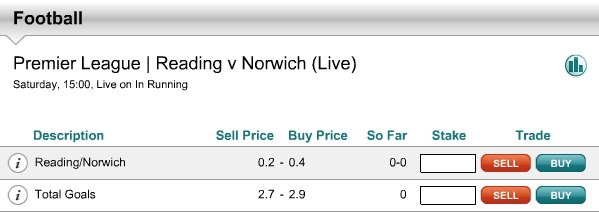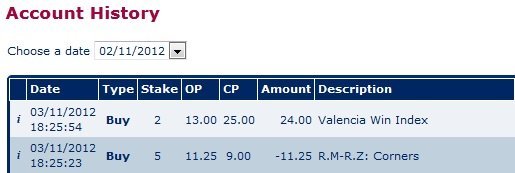Buying and Selling against an Opening Price
An opening price is set in units. Depending on the market a unit may be a goal, a point, a minute of play or any number of other things that can happen in a game. The opening price is set in the middle and replaces the need for odds to be given. This price reflects the average expected performance of the market with spread betting bookmakers wanting to take equal bets to sell as to buy. Essentially the opening price is what is expected to happen in the game. When placing a bet a stake the choice is to either buy or sell, and a stake per unit is selected. In image 2 the total goals in a game of Premier League football between Reading and Norwich (see Total Goals section for full market description) is offered at an opening price of 2.7 – 2.9 goals. This suggests that with 2 goals or less the match would be deemed relatively low scoring, and with 4 goals or more the match would be deemed relatively high scoring. The settlement price at the end of the game is compared against the opening price to give a profit or loss based on how many more or less units (in this case goals) there were.
As shown in image 2 the buy price will always be higher than the sell price offered, with a consistent gap between the two prices across similar markets. This is because spread betting bookmakers will take a cut for providing the market itself. This is similar with fixed odds betting as each betting market sets odds to return under 100% to allow bookmakers to take a cut for running the book on the market. In image 2 with the opening price at 2.7 – 2.9 the true price would be 2.8 goals with buying and selling offered 0.1 away from this.
For any market either the buy or the sell will lead to a profit, while the opposite bet would lead to a loss. The two are opposing so as things happen in a game one gains while the other loses.
Calculating Profit and Loss
The profit or loss from a spread bet is calculated as the difference between the opening price which was bought or sold at and the final settlement which reflects what actually happened. This difference in units is then multiplied by the stake selected per unit to give the overall profit or loss. The profit or loss changes each time the units change, so for example every time there is a goal or corner kick, or for every minute that passes. This means bets that are accurate (and many units better than the opening price) will be rewarded with large payouts relative to the stake per unit. Conversely calls or bets that are very poor (and many units worse than the opening price) will lead to large losses relative to the stake per unit.
Image 3 shows an example of two bets in La Liga. The top selection returns a profit of £24 to the account as the selection was to buy and the settlement price (known here as the CP or Closing Price) was above the opening price. The bottom selection was also to buy however the settlement price was below the opening price meaning a negative return and a deduction of £11.25 made to the account balance. Both win index and total corners which are shown in image 3 are covered later in the guide, they are simply shown here to demonstrate how profit and loss is tracked in a spread betting account.
Bet on qualifying sports spread betting markets in your first 28 days and get up to £300 cashback or an iPad
Click to ClaimFrancois is one of Howtobet4free’s co-founders and has written many of Howtobet4free’s popular Betting Guides. Francois also helps run the @howtobet4free_ Twitter account



